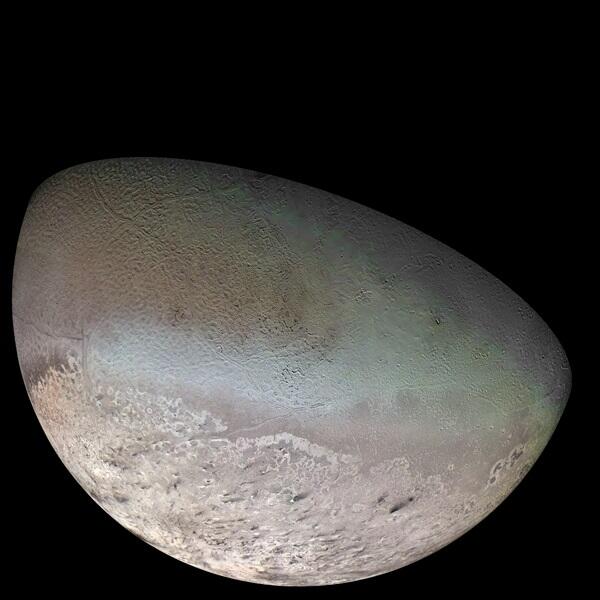Before it was eclipsed by Jupiter and Saturn’s ice-rich moons, Neptune’s largest moon Triton made a play to be recognized as one of the most interesting satellites in the solar system. But new research reveals Triton as a potential water-world. Large fractures on the surface hint towards a liquid ocean beneath the icy crust.
When Voyager 2 visited Neptune in 1989, it snapped the first images of Triton, revealing towering dark plumes and a tenuous nitrogen atmosphere. Few craters mar the crust, suggesting that something is resurfacing the young exterior. Triton’s density suggests a layer of ice or water only a few hundred kilometers thick.
“Triton is an interesting satellite. It was the first active satellite ever imaged,” says Terry Hurford, a planetary scientist at NASA Goddard Space Flight Center in Greenbelt, Maryland. Hurford examined the geyser-rich moon and found evidence that it may still have an ocean today. He presented his results at the Lunar and Planetary Sciences meeting in The Woodlands, Texas.
Today, ocean worlds abound in the solar system. Jupiter’s moon Europa hides an ocean beneath a thick icy crust. Two other Jupiter satellites, Ganymede and Callisto, are also considered ocean worlds. Saturn’s moon Enceladus not only carries an ocean but vents it through geysers at its southern pole, while another moon, Titan, boasts not only lakes and seas on the surface but a water-rich layer beneath the crust. Even tiny Pluto may hold a liquid ocean, while the subsurface water on its largest moon Charon has long since frozen.
After studying fractures on the surface and modeling how they may have evolved, Hurford thinks it’s time to add Triton to the club.
This image shows possible geyser activity on Triton, indicating the presence of an ocean below.
Give me a squeeze
On Europa, fractures in the surface come from tidal stresses. As the moon orbits the planet, it is slowly squeezed and released, breaking apart the surface. But Triton’s orbit is nearly circular, one of the roundest of any moon, so Neptune’s kneading today is limited.
In the past, however, Triton probably wasn’t quite as well-rounded. The moon holds the dubious fame of being the largest object to travel around its planet backwards, in what is known as a retrograde orbit. Its backward orbit suggests that Triton didn’t form around Neptune but is instead a captured object, an icy Kuiper Belt Object from the outer solar system. Its original eccentric orbit would have allowed Neptune to squeeze it more frequently, heating the interior and melting the ice.
“We definitely know Triton had an ocean in its past,” Hurford says. “It’s not clear whether or not that ocean stuck around.”
All that squeezing by Neptune would have caused the crust to split, creating fractures. Over time, as Triton’s orbit became more circular, the tidal stress would have decreased. With a circular orbit, tidal heating would decrease and the ocean would eventually freeze, leaving ancient fractures across the surface.
But the old fractions don’t fit well with the otherwise young outer layer suggested by cratering.
“There’s a disconnect between the age of the fractures and the age of the surface,” Herford says.
Fractures and canyons on the surface ice of Triton point to a dynamic world below the ice.
In an effort to bridge the gap, he began to examine how fractures could have formed more recently. Voyager 2 was only able to capture fractures on the Neptune side of the tidally locked moon, which keeps one face permanently turned towards its planet. The fractures, which run for hundreds of kilometers, bear a strong similarity to those found on the icy world Europa, which has an icy crust slowly squeezed by Jupiter.
Rather than focusing on how circular Triton’s orbit is, Hurford turned his attention to its gradual decay. The active moon isn’t staying put. Instead, it is slowly spiraling inward. In about 3.5 billion years, the moon will collide with its planet.
Herford found that the inward spiral would also create tidal stresses on the moon. With an ocean beneath its surface, the crust would continue to form fractures today. While ancient fractures from the original orbit may have been filled by active surface processes, new fractures would have continued to form.
Triton’s status as the first active moon may have kept scientists from recognizing that it could still host an ocean today. “When we first saw activity on the satellite, we weren’t thinking about ocean worlds,” Herford says. “Now that we’re starting to see oceans, we’re starting to rethink the method of eruptions on Triton.”
This was Voyager 2’s parting image of Neptune and Triton as it continued its long journey out of the solar system.
A chance to return
With their liquid-water oceans and hints of hydrothermal activity, Europa and Enceladus are considered two of the most promising sites in the solar system for life to have evolved. Because water is a key ingredient for life as we know it, all of the ocean worlds hold the hope of potential habitability.
“Anywhere you have an ocean, you have the possibility of life,” Herford says.
For Triton, habitability depends in part on the thickness of the icy shell, as well as what’s going on in the rocky layer interacting with the water. “We’re so new to thinking about this, we just don’t know,” Herford says.
So far, Triton observations have been limited to Earth-bound instruments and a single Voyager 2 flyby. But that could change. In 2013, the National Research Council’s Planetary Science Decadal Survey, which helps determine NASA’s upcoming missions, set as its third highest priority a mission to Uranus, after closely considering Neptune. Known as ice giants, the two worlds have different compositions from Jupiter and Saturn. Herford thinks that Neptune could be a contender for the next decadal survey, which is already under study.
“Maybe we’ll have a chance to go back,” he says.
Source: http://bit.ly/2oMjXw9











